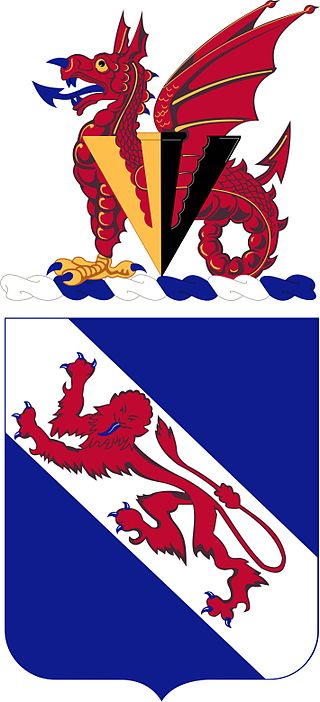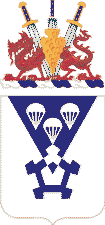
Airborne forces are ground combat units carried by aircraft and airdropped into battle zones, typically by parachute drop or air assault. Parachute-qualified infantry and support personnel serving in airborne units are also known as paratroopers.

The 82nd Airborne Division is an airborne infantry division of the United States Army specializing in parachute assault operations into denied areas with a U.S. Department of Defense requirement to "respond to crisis contingencies anywhere in the world within 18 hours". Based at Fort Liberty, North Carolina, the 82nd Airborne Division is part of the XVIII Airborne Corps. The 82nd Airborne Division is the U.S. Army's most strategically mobile division.

The 13th Airborne Division was an airborne forces formation of division-size of the United States Army that was active during World War II. The division was commanded for most of its existence by Major General Elbridge G. Chapman. It was officially activated in the United States in August 1943 at Fort Bragg in North Carolina, remaining active until February 1946, however it never saw combat.

The 17th Airborne Division, "The Golden Talons", was an airborne infantry division of the United States Army during World War II, commanded by Major General William M. Miley.

The 508th Infantry Regiment is an airborne infantry regiment of the United States Army, first formed in October 1942 during World War II. The 508th is a parent regiment under the U.S. Army Regimental System, and two battalions from the regiment are currently active: the 1st Battalion, 508th Parachute Infantry Regiment is assigned to the 3rd Brigade Combat Team, 82nd Airborne Division, and the 2nd Battalion, 508th Parachute Infantry Regiment is assigned to the 2nd Brigade Combat Team, 82nd Airborne Division. The regiment served in combat during World War II, and regimental elements have served in combat in the Dominican Republic, Vietnam, Grenada, Panama, Iraq and Afghanistan.

The 503rd Infantry Regiment, formerly the 503rd Parachute Infantry Regiment and the 503rd Airborne Infantry Regiment, is an airborne infantry regiment of the United States Army. The regiment served as an independent regiment in the Pacific War during World War II; at Fort Campbell, Kentucky; in Okinawa, Japan; and in Germany. Regimental elements have been assigned to the 2nd Infantry Division, the 11th Airborne Division, the 24th Infantry Division, 25th Infantry Division, the 82nd Airborne Division, 101st Airborne Division, and the 173rd Airborne Brigade Combat Team. Regimental elements have participated in campaigns in the Vietnam War, Operation Enduring Freedom–Afghanistan, and Operation Iraqi Freedom. The regiment claims 15 Medal of Honor recipients: two from World War II, ten from Vietnam, and three from Afghanistan. A parent regiment under the U.S. Army Regimental System. The regiment's 1st and 2nd Battalions are active, assigned to the 173rd Airborne Brigade, based at Caserma Ederle, Vicenza, Italy. The 3rd and 4th Battalions as well as Companies E, F, G, H, and I have been inactived.

The 507th Parachute Infantry Regiment, now the 507th Infantry Regiment, is an airborne infantry regiment of the United States Army. The regiment was initially assigned to the 82nd Airborne Division in World War II before transferring to the 17th Airborne Division. Now 1st Battalion, 507th Infantry Regiment is part of the United States Army Infantry School, subordinate to its Airborne and Ranger Training Brigade, responsible for the Army's Basic Airborne School, Jumpmaster School, Pathfinder School, and the "Silver Wings" Command Exhibition Parachute Team.

The 509th Infantry Regiment is an airborne infantry regiment of the United States Army. The unit was initially activated as a single battalion, the 504th Parachute Infantry Battalion, in October 1941 at Fort Benning, Georgia. Nicknamed "Geronimo", the 509th conducted the U.S. Army's first combat jump during World War II on 8 November 1942, flying 1,500 miles from England to seize Tafarquay airport in Oran, Algeria. The 509th made a total of five combat jumps during the war.

The 517th Parachute Regimental Combat Team was an airborne, specifically a parachute infantry, regiment of the United States Army that was formed in March 1943 during World War II, training at Camp Toccoa in the mountains of Northeast Georgia.

The 325th Airborne Infantry Regiment is a light infantry parachute insertion fighting force of the United States Army. The subordinate units of the regiment constitute the bulk of the infantry elements assigned to the 2nd Infantry Brigade Combat Team, 82nd Airborne Division.

The 505th Parachute Infantry Regiment, originally the 505th Infantry Regiment, is an airborne infantry regiment of the United States Army, one of four infantry regiments of the 82nd Airborne Division of the United States Army, with a long and distinguished history.

The 504th Infantry Regiment, originally the 504th Parachute Infantry Regiment, is an airborne forces regiment of the United States Army, part of the 82nd Airborne Division, with a long and distinguished history. The regiment was first formed in mid-1942 during World War II as part of the 82nd Airborne Division and saw service in Sicily, Italy, Anzio, the Netherlands, Belgium and Germany.

Major General Reuben Henry Tucker III was a highly decorated senior officer in the United States Army. He served with distinction during World War II, where he commanded the 504th Parachute Infantry Regiment in Sicily, Italy, The Netherlands, Belgium and Germany from 1942 to 1945. He was one of the youngest regimental commanders of the war.

The 460th Parachute Field Artillery Battalion was an airborne field artillery battalion of the United States Army that saw active service during World War II. Active from 1943–1946, the battalion trained with the 17th Airborne Division; served with the 517th Parachute Regimental Combat Team in the Italian Campaign, Operation Dragoon, and the Battle of the Bulge; and ended the war assigned to the 13th Airborne Division before inactivation.

The 501st Infantry Regiment, previously the 501st Parachute Infantry Regiment and 501st Airborne Infantry Regiment, is an airborne forces regiment of the United States Army with a long history, having served in World War II and the Vietnam War, both as part of the 101st Airborne Division, as well as the War in Afghanistan. It is the first airborne unit by designation in the United States Armed Forces. Its 1st Battalion is assigned to the 2nd Infantry Brigade Combat Team (Airborne), 11th Airborne Division, located at Fort Richardson, Alaska. Its 2nd Battalion is assigned to the 1st Brigade Combat Team, 82nd Airborne Division, located at Fort Liberty, North Carolina.
The 1st Airborne Task Force was a short-lived Allied airborne unit that was active during World War II created for Operation Dragoon–the invasion of Southern France. Formed in July 1944, under the command of Major General Robert T. Frederick, it took part in the "Dragoon" landings on 15 August 1944, securing the area north-west of the landing beaches, before moving towards the French–Italian border as part of the United States Seventh Army. The unit was disbanded in November 1944.
Mission Boston was a parachute combat assault at night by Major General Matthew Ridgway's U.S. 82nd Airborne Division on June 6, 1944, part of the American airborne landings in Normandy during World War II. Boston was a component element of Operation Neptune, the assault portion of the Allied invasion of Normandy, codenamed Operation Overlord. 6,420 paratroopers jumped from nearly 370 C-47 Skytrain troop carrier aircraft into an intended objective area of roughly 10 square miles (26 km2) located on either side of the Merderet river on the Cotentin Peninsula of France, five hours ahead of the D-Day landings.

The 319th Field Artillery Regiment, more commonly referred to as the 319th Airborne Field Artillery Regiment, is a parent regiment in the U.S. Army Regimental System. Four battalions of the regiment are currently active. The first three battalions 1st Battalion, 319th Field Artillery Regiment, 2nd Battalion, 319th Field Artillery Regiment, 3rd Battalion, 319th Field Artillery Regiment are in the 82nd Airborne Division and the 4th Battalion, 319th Field Artillery Regiment is in the 173rd Airborne Brigade.
The 377th Field Artillery Regiment is a field artillery regiment of the United States Army. A parent regiment under the U.S. Army Regimental System, the regiment's 2nd Battalion, 377th Field Artillery Regiment is assigned to the 2nd Infantry Brigade Combat Team (Airborne), 11th Airborne Division. Elements of the regiment have also served with the 101st Airborne Division and 82nd Airborne Division, and have seen service in World War II, Vietnam, and in both Iraq and Afghanistan during the Global War on Terror. The 1st and 3rd Battalions as well as Batteries D and E are Inactive.

The 326th Infantry Regiment was an infantry regiment of the United States Army that saw active service during World War I, as part of the 82nd Division and fought in the Meuse-Argonne Offensive and was inactivated in 1919. The regiment was reactivated during World War II, again as part of the 82nd Infantry Division, and was converted into a glider infantry formation, becoming the 326th Glider Infantry Regiment. Originally part of the 82nd Airborne Division, the regiment transferred to the 13th Airborne Division. However, despite training for almost three years, the 326th was never involved in any combat.

















